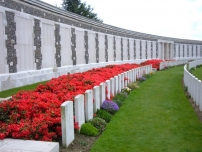| First Name: | Robert Francis | Last Name: | ROBINSON | |
|---|---|---|---|---|
| Date of Death: | 17/08/1917 | Lived/Born In: | Bloomsbury | |
| Rank: | Rifleman | Unit: | Rifle Brigade12 | |
| Memorial Site: | 1. St Pancras Church window 2. Tyne Cot Memorial, Belgium | |||
Current Information:Age-31 25, Burton Street, Bloomsbury
Third Battle of Ypres This was a campaign fought between July and November 1917 and is often referred to as the Battle of Passchendaele, a village to the north-east of Ypres which was finally captured in November. It was an attempt by the British to break out of the Ypres salient and capture the higher ground to the south and the east from which the enemy had been able to dominate the salient. It began well but two important factors weighed against them. First was the weather. The summer of 1917 turned out to be one of the the wettest on record and soon the battlefield was reduced to a morass of mud which made progress very difficult, if not impossible in places. The second was the defensive arrangements of concrete blockhouses and machine gun posts providing inter-locking fire that the Germans had constructed and which were extremely difficult and costly to counter. For 4 months this epic struggle continued by the end of which the salient had been greatly expanded in size but the vital break out had not been achieved. The Battle of Langemarck This took place between 16th-18th August, 1917 and was the second general attack of 3rd Ypres. Although it did not rain during the two days of the battle itself there had been plenty of it in the preceding days and in many places the battlefield was a quagmire. On the left of the attack in the north-west of the Ypres salient there was considerable success, especially for the French Army which attacked on the left of the British, but the attack on the Gheluvelt Plateau, due east of Ypres, met determined German resistance and the early gains were soon reversed. At 4.45am on 16th August, 20th Division attacked in the northern part of the battle front towards the village of Langemarck itself. They used 60 and 61 Brigades for this successful operation and by 7.45am the final objectives had been captured. 60 Brigade attacked on the right with 6th Oxford & Bucks Light Infantry in front and 6th Shropshire Light Infantry and 12th King’s Royal Rifle Corps, following behind. 12th Rifle Brigade were in reserve with one of their companies attached to 6th Oxford & Bucks as ‘moppers-up’, following close on their heels, dealing with any of the enemy left behind. In the middle of the morning reports were coming in of a German division concentrating near Poelcapelle and as a consequence, 12th Rifle Brigade were ordered across the Steenbeke, a small stream, to help deal with any counter attack that might develop. One company acted as a carrying party, taking supplies forward to the front line. Overnight the battalion moved further forward and on the following day, 17th August, they took part in a counter attack to recapture Eagle Trench, which had been taken but then lost on the previous day. Between 6.30pm and 7.00pm there was an artillery barrage on Eagle trench during which time, those detailed for the counter-attack moved forward from the Langemarck-Alouette Farm road and at 7.00pm, zero hour, the attack commenced. Two large shells fell near the leading line and caused some casualties but a bigger problem came from a German strongpoint, Rat House, on the right from where sniper and machine-gun fire inflicted considerable damage. They also met fire from in front and the casualty list rose even further. and with nearly two thirds of their number either killed or wounded the attack ground to a halt. Only a little ground had been gained and Eagle Trench remained firmly in enemy hands. Among those from 12th Rifle Brigade who were killed in this operation was Robert Robinson. |
||||
| « Back to Search Results | ||||
| If you think any of the information shown here is incorrect, Click Here to submit your amends and comments | ||||




